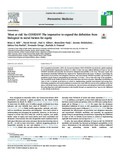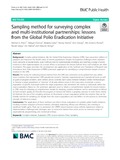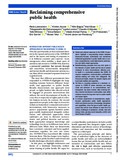Browsing Journal Articles (2020) by Issue Date
Now showing items 41-60 of 71
-
Translating international guidelines for use in routine maternal and neonatal healthcare quality measurement
(Taylor & Francis, 2020-07-13)Background: Improving facility-based quality for maternal and neonatal care is the key to reducing morbidity and mortality rates in low- and middle-income countries. Recent guidance from WHO and others has produced a large ... -
Carrying out embedded implementation research in humanitarian settings: A qualitative study in Cox's Bazar, Bangladesh
(PLOS ONE, 2020-07-16)Background: Embedded implementation research (IR) promotes evidence-informed policy and practices by involving decision-makers and program implementers in research activities that focus on understanding and solving existing ... -
Mapping geographical inequalities in oral rehydration therapy coverage in low-income and middle-income countries, 2000–17
(Elsevier, 2020-08)Background: Oral rehydration solution (ORS) is a form of oral rehydration therapy (ORT) for diarrhoea that has the potential to drastically reduce child mortality; yet, according to UNICEF estimates, less than half of ... -
Measuring motivation among close-to community health workers: Developing the CTC Provider Motivational Indicator Scale across six countries
(BMC, 2020-08-01)Background: Close-to-community (CTC) health service providers are a cost-effective and important resource in the promotion of and increasing access to health services. However, many CTC provider programmes suffer from ... -
‘Most at risk’ for COVID19? The imperative to expand the definition from biological to social factors for equity
(Elsevier, 2020-08-06)First recognized in December 2019, the Coronavirus Disease 2019 (COVID19) was declared a global pandemic by the World Health Organization on March 11, 2020. To date, the most utilized definition of ‘most at risk’ for COVID19 ... -
Synthesis and translation of research and innovations from polio eradication (STRIPE): Initial findings from a global mixed methods study
(BMC, 2020-08-12)Background: Lessons from polio eradication efforts and the Global Polio Eradication Initiative (GPEI) are useful for improving health service delivery and outcomes globally. The Synthesis and Translation of Research ... -
Sampling method for surveying complex and multi-institutional partnerships: Lessons from the Global Polio Eradication Initiative
(BMC, 2020-08-12)Background: Complex global initiatives, like the Global Polio Eradication Initiative (GPEI), have prevented millions of paralyses and improved the health status of diverse populations. Despite the logistical challenges ... -
Evaluating the process of partnership and research in global health: Reflections from the STRIPE project
(BMC, 2020-08-12)Background: Thoughtful and equitable engagement with international partners is key to successful research. STRIPE, a consortium of 8 academic and research institutions across the globe whose objective is to map, synthesize, ... -
Attitudes and practices of public health academics towards research funding from for-profit organizations: Cross-sectional survey
(Springer Link, 2020-08-25)Objectives: The growing trend of for-profit organization (FPO)-funded university research is concerning because resultant potential conflicts of interest might lead to biases in methods, results, and interpretation. For ... -
Factors associated with tobacco use among Nepalese men aged 15–49 years: Data from Nepal demographic and Health Survey 2016
(Elsevier, 2020-09)Background Tobacco is one of the leading causes of premature death around the world. In Nepal, tobacco kills 15,000 people every year. Men are also the primary users of tobacco. This study aimed to discern the prevalence ... -
Mapping geographical inequalities in access to drinking water and sanitation facilities in low-income and middle-income countries, 2000–17
(The Lancet, 2020-09)Background: Universal access to safe drinking water and sanitation facilities is an essential human right, recognised in the Sustainable Development Goals as crucial for preventing disease and improving human wellbeing. ... -
Reclaiming comprehensive public health
(BMJ Journals, 2020-09-25)Over the past 6 months, we have witnessed diversity in the spread and severity of the COVID-19 and in the nature and timing of responses to it in different countries and contexts.1 Acute emergencies often mobilise a short ... -
Economic evaluation of culprit lesion only PCI vs. immediate multivessel PCI in acute myocardial infarction complicated by cardiogenic shock: the CULPRIT‑SHOCK trial
(Springer Link, 2020-10-07)Background The CULPRIT-SHOCK trial compared two treatment strategies for patients with acute myocardial infarction and multivessel coronary artery disease complicated by cardiogenic shock: (a) culprit vessel only percutaneous ... -
Health, illness and healthcare-seeking behaviour of the street dwellers of Dhaka City, Bangladesh: Qualitative exploratory study
(BMJ Journals, 2020-10-07)Objective: This study explored the illness experiences and healthcare-seeking behaviour of a cross-section of street dwellers of Dhaka City for designing a customised intervention. Design A qualitative exploratory study ... -
Availability of equipment and medications for non-communicable diseases and injuries at public first-referral level hospitals: A cross-sectional analysis of service provision assessments in eight low-income countries
(BMJ Journals, 2020-10-10)Context and objectives: Non-communicable diseases and injuries (NCDIs) comprise a large share of mortality and morbidity in low-income countries (LICs), many of which occur earlier in life and with greater severity than ... -
Mothers’ education and the effectiveness of nutrition programmes: Evidence from a matched cross-sectional study in rural Bangladesh
(Taylor & Francis, 2020-10-14)BRAC Bangladesh trains community health workers to communicate about nutrition in its Maternal, Newborn and Child Health programme. We estimate the programme’s impact on nutrition outcomes among rural Bangladeshi children ... -
Global burden of 87 risk factors in 204 countries and territories, 1990–2019: a systematic analysis for the Global Burden of Disease Study 2019
(Elsevier, 2020-10-17)Background: Rigorous analysis of levels and trends in exposure to leading risk factors and quantification of their effect on human health are important to identify where public health is making progress and in which cases ... -
Five insights from the Global Burden of Disease Study 2019
(Elsevier, 2020-10-17)The Global Burden of Diseases, Injuries, and Risk Factors Study (GBD) 2019 provides a rules-based synthesis of the available evidence on levels and trends in health outcomes, a diverse set of risk factors, and health system ... -
Global burden of 369 diseases and injuries in 204 countries and territories, 1990–2019: A systematic analysis for the Global Burden of Disease Study 2019
(Elsevier, 2020-10-17)Summary: Background In an era of shifting global agendas and expanded emphasis on non-communicable diseases and injuries along with communicable diseases, sound evidence on trends by cause at the national level is ... -
Global age-sex-specific fertility, mortality, healthy life expectancy (HALE), and population estimates in 204 countries and territories, 1950–2019: A comprehensive demographic analysis for the Global Burden of Disease Study 2019
(Elsevier, 2020-10-17)Summary: Background Accurate and up-to-date assessment of demographic metrics is crucial for understanding a wide range of social, economic, and public health issues that affect populations worldwide. The Global Burden ...


















